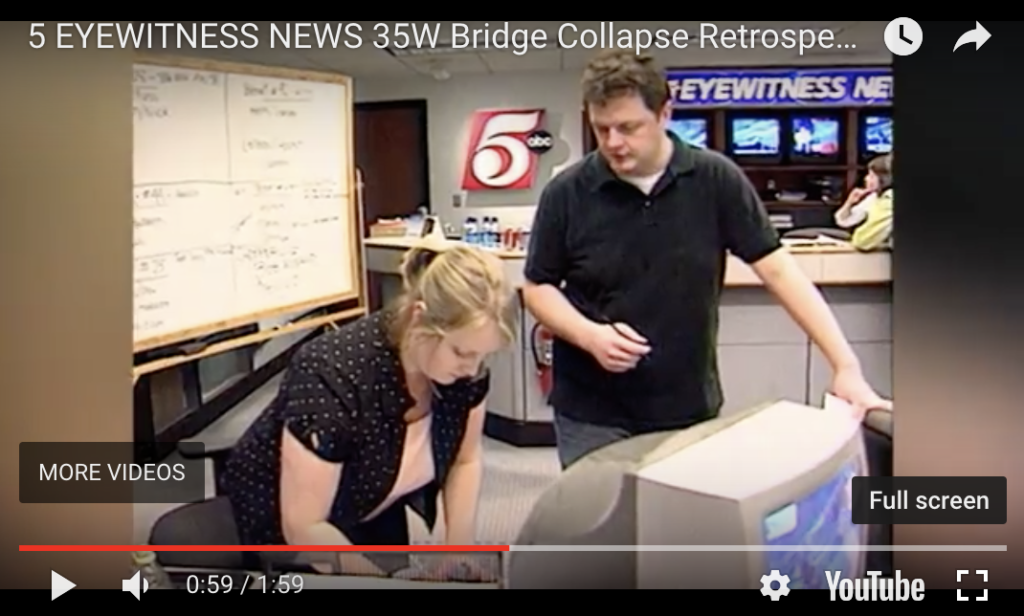A powerful story is a story that matters. One that impacts an entire community.
We love telling stories that make a difference. In fact, before she launched mConnexions, our Principal Strategist, Julie Holton built a career on telling stories on TV news. As an Executive Producer, she led teams of news reporters and producers at stations throughout the country.
Recently, Julie sat down with Paul Schmidt Uno Deuce Multimedia to talk about her experience working in news.
One major story that stands out was her team’s coverage of the major and tragic 2007 collapse of the I-35W bridge in Minneapolis. In this video, Julie shares her race to break the news, and her dedication to sharing the story with the community during a major crisis.
VIDEO TRANSCRIPT
Paul: What was it like for you to work in a newsroom? Tell us about your history.
Julie: I jokingly refer to it as my tour of duty, because when you work in news you tend to you move around a lot when you’re trying to move up in position and station size. When I was still at CMU, I got my start here in Lansing at WLNS. From WLNS, I went to WNEM in Saginaw for a short time before I then graduated to college and went to Richmond, VA. After a few years in Richmond, I jumped to Minneapolis (the 13th largest market in the U.S.) and stayed there for five years. After that, I went from one –apolis to another—I transferred from Minneapolis, I transferred down to Indianapolis for a few years, getting slowly closer to home. After staying in Indy for a few years, I decided at that point that my time in the fast-paced, pressure cooker environment was coming to the end—I knew I wasn’t going to do it forever. So, I moved back to Michigan and ended my TV career at the station where it started—WLNS in Lansing. So, it was a 12-year span at several different stations, in several different states.
Paul: A lot of folks think of the on-air personalities when they think of the people in the newsroom. What was your role in the newsroom?
Julie: I was a producer for several years, then I was an executive producer for a majority of my career. So in short, I was somewhere in between the person on camera and the janitor! Who really knows what a producer does?! Each newscast generally has its own producer. They are in charge of finding stories, selecting which stories are going to be in the newscast, and writing the stories. They are also in charge of coming up with all the graphic elements that support with the stories: anything and everything from the images you see over the news anchors’ shoulders, to working with reporters and their photographers to decide which elements they need. They actually assemble and write, and put together the entire newscast.
Julie: Executive producers oversee that entire process. They oversee multiple shows and work with each producers on those shows. They also work with the reporters who are out in the field gathering the elements they need to put their stories together.
Paul: What part did you like the best?
Julie: Telling people’s stories. Every single day was completely different, which is a good thing and a bad thing. It’s a lot of work! But at the end of the day, you are telling stories that make a difference. That’s another way journalists get a bad rap—they are portrayed, especially on TV, as being pushy and getting in people’s faces after tragedy happens. Yes, that happens. But, the people who are dedicated and care about it are there getting the story to share that person’s tragedy. After you have experienced some sort of loss, many people want to share it and talk about their loved one, or help make a difference so whatever it is that happened doesn’t happen to someone else. Those are the stories that make a difference, especially at a local level.

Julie: One example from my career was the I-35W bridge collapse when I was working in Minneapolis. Thirteen people died, hundred were injured: it was an incredibly horrible tragedy that happened at the height of rush hour. Bridges aren’t supposed to fall down: this was a major interstate, a bridge that I drove every single day to get from Minneapolis to St. Paul. As a journalist and/or a news producer, you are living the story you are telling. So, I was living this story. We were on the air for 27 hours straight, and it was just this unbelievable adrenaline rush. When you’re in that moment, you don’t stop because there are people calling into the newsroom looking for answers, looking for loved ones, wanting more information. In this situation, we were dealing with that, we had to get the information on the Red Cross out to people, we had to broadcast live when the President flew in. With big stories like this, all the national networks come in and converge to broadcast. They need the local producers’ assistance, because on a local level, they have all the resources. At the end of the day, you’re telling the story that is impacting your community. You are making a difference by getting that information out to people. That’s why I did for so long.


